rookery
Tired seal pup seeks rest on Seattle's busiest beach
Jul/27/16 09:19 PM
This past weekend, the scene at Alki Beach in West Seattle was indeed a crazy one. The annual Alki Art Fair, with live music, art exhibits, craft and jewelry booths and food vendors, lined the crowded beach promenade. The many participants included Seal Sitters MMSN, where volunteers manned a booth displaying educational materials and a hands-on art project for kids.
Adding to the throng of people, there was a beach volleyball tournament taking place mid-beach with hundreds of participants and fans. A steady stream of people toting kayaks and paddle boards crossed the beach from Alki Kayak rentals and lingered offshore. Families picnicked and kids played in the shallows.
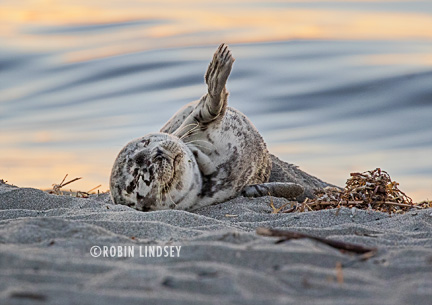 Amid all this chaos, a tiny and thin harbor seal pup sought sanctuary to rest and flopped ashore late Saturday afternoon - smack dab in front of the volleyball courts. First responders taped off the area and the young pup rested until dusk (stretching in the evening light, photo at left) before returning to Puget Sound.
Amid all this chaos, a tiny and thin harbor seal pup sought sanctuary to rest and flopped ashore late Saturday afternoon - smack dab in front of the volleyball courts. First responders taped off the area and the young pup rested until dusk (stretching in the evening light, photo at left) before returning to Puget Sound.
Over the course of three days, the pup nicknamed Little One came and went from the stretch of sandy beach at Alki, keeping Seal Sitters First Responders on their toes and requiring long hours of protection. Seal Sitters volunteers pitched in to help keep the pup safe on this beach, popular with sunbathers, swimmers and water sports - and (illegal) dogs.
Keeping kayakers and paddle boarders away was our most difficult challenge. The pup showed obvious signs of stress when these small vessels were within 50 yards of shore. Little One was too young to understand the dangers on land.
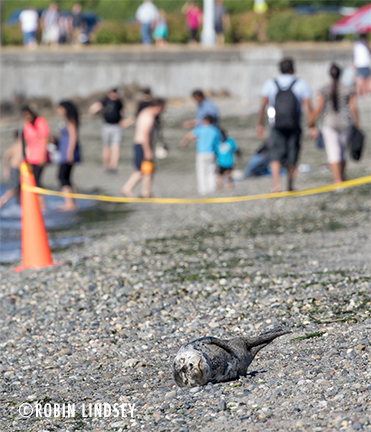 What could have been Seal Sitters’ worst nightmare of a pup on a crowded urban beach ended up being a fantastic few days with an appreciative and respectful public. In addition to folks from the Puget Sound region, our volunteers educated visitors from all over the U.S. and world, including China, Australia, Germany, Wyoming, Georgia, Philadelphia, Ohio, Texas, Oklahoma, Missouri, California, and Alberta, Canada. The many thank-you’s from these visitors and residents were perks to tired volunteers.
What could have been Seal Sitters’ worst nightmare of a pup on a crowded urban beach ended up being a fantastic few days with an appreciative and respectful public. In addition to folks from the Puget Sound region, our volunteers educated visitors from all over the U.S. and world, including China, Australia, Germany, Wyoming, Georgia, Philadelphia, Ohio, Texas, Oklahoma, Missouri, California, and Alberta, Canada. The many thank-you’s from these visitors and residents were perks to tired volunteers.
Each day, the pup lingered longer onshore. Late Monday afternoon, Seal Sitters’ Lead Investigator consulted with a marine mammal veterinarian and Stranding Network marine mammal experts about the pup’s thin condition, as well as the inherently dangerous location.
Working together to make a joint decision based on limited rehabilitation options, it was determined that the pup would be captured the following day. Little One would be relocated to a safer area, the closest harbor seal haul-out and rookery site, where the estimated 3-4 week old pup could potentially get adopted or even reunite with mom.
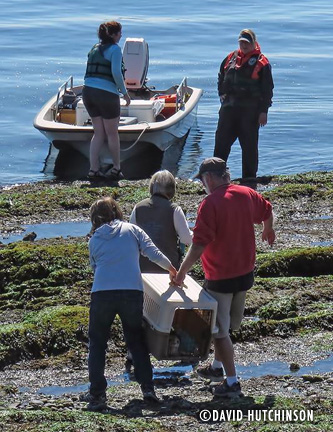 Little One came ashore very early morning the 4th day. She returned to the water twice - once due to kayakers too close and the second trip due a pesky, pecking seagull. Seal Sitters First Responders worried that they might not have an opportunity for a successful capture.
Little One came ashore very early morning the 4th day. She returned to the water twice - once due to kayakers too close and the second trip due a pesky, pecking seagull. Seal Sitters First Responders worried that they might not have an opportunity for a successful capture.
Finally, the pup finally settled in about 10 feet from the tide line. First Responders quietly crept along the water’s edge and picked up Little One. Only members of NOAA’s Marine Mammal Stranding Network are authorized to handle marine mammals, who are protected by Federal law. It is illegal for others to touch, feed, or move seal pups.
The pup was transported to a quieter location, where a boat with WDFW Marine Mammal Investigations Unit’s marine mammal biologist and volunteer was waiting to whisk Little One away.
The small female pup was examined, hydrated with fluids and Dextrose for energy and released at a seal haul-out, where up to 100 harbor seals gather at times. A red tag was placed on Little One’s rear flipper before being set free, in hopes of re-sighting her on the ridge of rocks situated safely in the Sound, far away from humans and dogs. We will provide updates if the pup is sighted during WDFW-MMI’s frequent surveys of the area.
Thanks to all of the Seal Sitters volunteers who showed poise and patience under trying circumstances in extremely hot weather.
We are grateful to our consulting partners in NOAA MMSN, most notably WDFW-MMI for literally going the extra mile to relocate the pup.
Special thanks to the many people who let Seal Sitters know when Little One came ashore on Saturday and Sunday, enabling us to protect the vulnerable pup as soon as possible.
Seal Sitters hotline received reports of two other pups on Sunday and Monday, but they could not be located when our responder arrived. Entering our hotline number, 206-905-7325 (SEAL), into your cell phone can mean quicker volunteer responses and help us protect seal pups in a timely manner.
Adding to the throng of people, there was a beach volleyball tournament taking place mid-beach with hundreds of participants and fans. A steady stream of people toting kayaks and paddle boards crossed the beach from Alki Kayak rentals and lingered offshore. Families picnicked and kids played in the shallows.

Over the course of three days, the pup nicknamed Little One came and went from the stretch of sandy beach at Alki, keeping Seal Sitters First Responders on their toes and requiring long hours of protection. Seal Sitters volunteers pitched in to help keep the pup safe on this beach, popular with sunbathers, swimmers and water sports - and (illegal) dogs.
Keeping kayakers and paddle boarders away was our most difficult challenge. The pup showed obvious signs of stress when these small vessels were within 50 yards of shore. Little One was too young to understand the dangers on land.

Each day, the pup lingered longer onshore. Late Monday afternoon, Seal Sitters’ Lead Investigator consulted with a marine mammal veterinarian and Stranding Network marine mammal experts about the pup’s thin condition, as well as the inherently dangerous location.
Working together to make a joint decision based on limited rehabilitation options, it was determined that the pup would be captured the following day. Little One would be relocated to a safer area, the closest harbor seal haul-out and rookery site, where the estimated 3-4 week old pup could potentially get adopted or even reunite with mom.

Finally, the pup finally settled in about 10 feet from the tide line. First Responders quietly crept along the water’s edge and picked up Little One. Only members of NOAA’s Marine Mammal Stranding Network are authorized to handle marine mammals, who are protected by Federal law. It is illegal for others to touch, feed, or move seal pups.
The pup was transported to a quieter location, where a boat with WDFW Marine Mammal Investigations Unit’s marine mammal biologist and volunteer was waiting to whisk Little One away.
The small female pup was examined, hydrated with fluids and Dextrose for energy and released at a seal haul-out, where up to 100 harbor seals gather at times. A red tag was placed on Little One’s rear flipper before being set free, in hopes of re-sighting her on the ridge of rocks situated safely in the Sound, far away from humans and dogs. We will provide updates if the pup is sighted during WDFW-MMI’s frequent surveys of the area.
Thanks to all of the Seal Sitters volunteers who showed poise and patience under trying circumstances in extremely hot weather.
We are grateful to our consulting partners in NOAA MMSN, most notably WDFW-MMI for literally going the extra mile to relocate the pup.
Special thanks to the many people who let Seal Sitters know when Little One came ashore on Saturday and Sunday, enabling us to protect the vulnerable pup as soon as possible.
Seal Sitters hotline received reports of two other pups on Sunday and Monday, but they could not be located when our responder arrived. Entering our hotline number, 206-905-7325 (SEAL), into your cell phone can mean quicker volunteer responses and help us protect seal pups in a timely manner.
Harbor seal pupping season in full swing in South Puget Sound
Aug/30/14 03:05 PM
 Seal Sitters has responded to 5 harbor seal pups in 5 West Seattle locations in the past week as pups leave the safety of the area’s rookeries. We are now in the midst of seal pupping season!
Seal Sitters has responded to 5 harbor seal pups in 5 West Seattle locations in the past week as pups leave the safety of the area’s rookeries. We are now in the midst of seal pupping season! On South Puget Sound’s islands, sand bars, rocky spits and log booms, rotund harbor seal pups are begging for a last drink of mom’s rich milk, almost 50% fat, before venturing off on their own. Many more have already been weaned and are now facing formidable challenges and hazards in their struggle to survive the first year of life. By August 15th, 90% of all harbor seal pups had been born in South Puget Sound (view pupping season map here). As of today, well over half of those pups have been weaned - including the pup shown above, born in Sinclair Inlet on July 2nd.
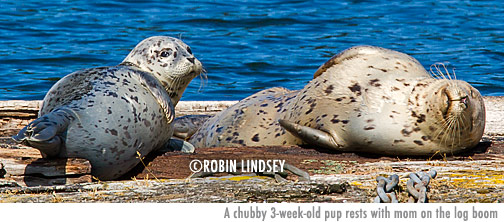
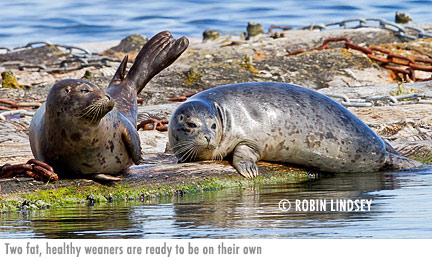
Even though seal pups learn to forage with moms near the rookery, catching fast-swimming little fish is a daunting task and some are more successful than others. Since their muscles still have not fully developed, it affects their ability to dive for long periods. As the weeks pass, their body weight can drop noticeably.
At the haul-out toward the end of the pupping season (late June through September in South Puget Sound), testosterone-laced males, intent on attracting mates, show off with aquatic displays (porpoising, tail-slapping, bubble blowing) at the water’s surface and compete for space on the haul-out. Adults become grumpy and spend many hours on land during the uncomfortable molt. Food sources can become depleted with so many seals concentrated in a small area. The idyllic world of attentive and affectionate moms is no longer so for weaners. This is the time that many of them strike out on their own, a solitary journey.
By mid-September, 90% of all harbor seal pups will be weaned in South Puget Sound. This means that by then almost every seal pup that is alone onshore has no mom nearby, waiting to nourish them. Consequently, weaners are most often thin and in a daily struggle to survive against predators, disease and malnutrition. Low body weight increases opportunities for parasites and viruses. They must conserve precious calories, so it is urgent to give them space to rest on our urban beaches.
Still, we cannot rule out that pups who are still nursing age will visit our shores as well over the next 6 or more weeks. If a mom is nearby and sees a disturbance near her pup, she will very likely abandon him - adult seals are notoriously shy and wary of people and predators.
Always stay back and keep people and dogs away from resting seals. In West Seattle, call Seal Sitters Marine Mammal Stranding Network’s hotline @ 206-905-SEAL (7325). To view a map of NOAA’s stranding networks in Washington State with contact information, click here.
"Share the Shore" this holiday weekend
Jul/04/14 10:35 AM
Independence Day weekend is a time when people head to the beach to enjoy some fun and, hopefully, sun. Please remember that this is a sensitive time of year for harbor seals. July is smack-dab in the middle of pupping season on the Outer Coast and pups are now being born in the inland waters of the Strait of Juan de Fuca and Puget Sound. Whenever possible, please stay 100 yards away from harbor seals (NOAA recommendation), including haulouts, many of which are now rookeries full of pregnant females and newborn pups. Disturbance often has drastic consequences. Newborn pups are not ready for “independence” until they have been weaned at least 4-6 weeks old.
July 4th weekend is no holiday for wildlife. Fireworks, loud music, people and off leash dogs can cause newborn seal pups (and young of other species) to be abandoned. Please enjoy nature responsibly and stay back from any seals resting on the beach.
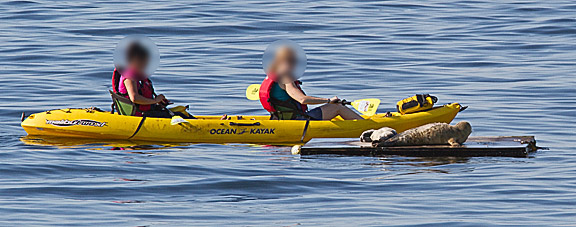 Boaters, kayakers and paddle boarders should remember to stay well away from platforms, docks, buoys and harbor seal haulouts with resting animals. Newborn pup Sparkle was abandoned by her mom due to boater harassment last season (photo left). The emaciated pup later died in rehab.
Boaters, kayakers and paddle boarders should remember to stay well away from platforms, docks, buoys and harbor seal haulouts with resting animals. Newborn pup Sparkle was abandoned by her mom due to boater harassment last season (photo left). The emaciated pup later died in rehab.
Pupping season in South Puget Sound is from late June-September (view timeline map here). All marine mammals are protected by federal law (the MMPA) from harassment. Please, “Share the Shore” with wildlife! Read related post about disturbance here.
It is not unusual to see a harbor seal pup alone on the beach. It doesn’t mean the pup is abandoned. Sometimes, a young pup is not strong enough to go foraging with mom for hours. In most cases, the mother seal will return later. Stay back, keep dogs leashed and notify your local stranding network if you have concerns.
No new information has been released about the recent seal killing near Grayland Beach on the Washington Coast. A reward has been offered in the case, the second brutal killing of a harbor seal in a month.
July 4th weekend is no holiday for wildlife. Fireworks, loud music, people and off leash dogs can cause newborn seal pups (and young of other species) to be abandoned. Please enjoy nature responsibly and stay back from any seals resting on the beach.

Pupping season in South Puget Sound is from late June-September (view timeline map here). All marine mammals are protected by federal law (the MMPA) from harassment. Please, “Share the Shore” with wildlife! Read related post about disturbance here.
It is not unusual to see a harbor seal pup alone on the beach. It doesn’t mean the pup is abandoned. Sometimes, a young pup is not strong enough to go foraging with mom for hours. In most cases, the mother seal will return later. Stay back, keep dogs leashed and notify your local stranding network if you have concerns.
No new information has been released about the recent seal killing near Grayland Beach on the Washington Coast. A reward has been offered in the case, the second brutal killing of a harbor seal in a month.
Premature pup Ali dies in peace on protected beach
Jun/25/14 06:30 AM
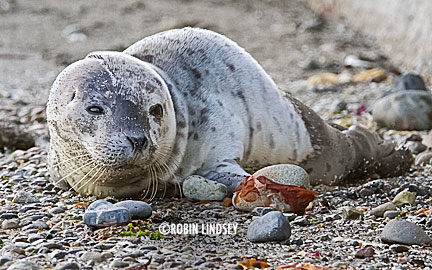
The premature pup originally sighted offshore on Friday, June 20th, worked his way a bit further south along the private stretch of Beach Drive and spent the past several days resting there under the watchful eye of neighbors and Seal Sitters first responders.
The thin pup died last evening. Abandoned by mom (circumstances unknown) and not meeting NOAA’s requirements for rehabilitation (read NOAA policy here), he was given the chance to rest and die in peace in on a quiet beach thanks to caring neighbors. Full-term seal pups have only a 50% chance of surviving their first year and survival rates of premature pups are greatly reduced in the wild. The beautiful little male pup, nicknamed Ali and a true fighter, was examined postmortem - photos of teeth will help our consulting marine mammal biologist estimate age.
Please check back for Seal Sitters' update as we receive more input from the biologist. Heartfelt thanks to everyone who so graciously allowed SS volunteers onto their property to observe and educate neighbors about this sweet little pup. It was a difficult and complicated situation for all involved.
Please contact Seal Sitters' hotline at 206-905-7325 (SEAL) if you have a marine mammal, dead or alive, on your beach.
Full-term harbor seal pups are just now being born in South Puget Sound area rookeries. View WDFW’s seal cam for a chance to see the pup born Monday evening, as well as lanugo pups at a protected harbor seal haulout. You might even get lucky and see a birth! By mid-July full-term pups will outnumber lanugos in the rookeries as seal pupping season will be in full swing in our area.
PUPDATE (June 26, 2014)
After review of photos, WDFW’s marine mammal biologist estimates that premature Ali was about a week old.
Happy Mother's Day to all species
May/10/15 07:35 AM
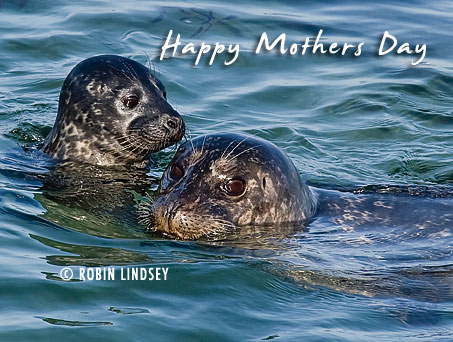
This day is a reminder, too, that spring is the time for birthing of many wildlife species. Seals and sea lions are now being born along the Pacific coastline. Share the Shore - stay back and do not disturb! To view a map which show the pupping season timeline in Oregon and Washington, click here.
Harbor seal moms form affectionate bonds with their pups. Immediately after birth (see birth photos here), a mom must memorize the scent and call of her newborn so she can locate the pup if they are separated. Pups weigh between 18-30 lbs when born. Mom will nurse her pup for 4-6 weeks and then the chubby pup is on his own - now gaunt from nourishing her pup, she needs to replenish her own fat stores. During that short time, she must teach her pup all the skills to survive against daunting odds - only 50% of pups survive the first year.
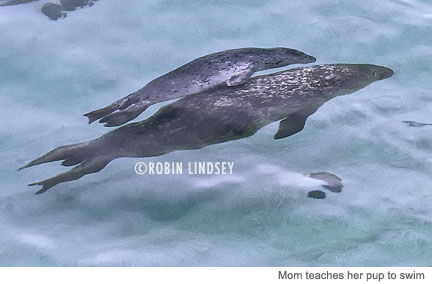
Sometimes, a mom will leave her pup, who may not be strong enough to forage for hours, alone to rest on shore. She returns later to nourish her hungry pup. Always stay back from a resting pup. Otherwise, the mom may abandon her young due to human interference.
And finally, a “shout-out” to our Seal Sitters volunteers who are moms. These great women teach their children that respect for wildlife and concern for the health of our waterways is an empowering lesson to be learned and shared with others. We cannot thank you enough.
First seal pups of season born on Washington and Oregon coasts
May/02/14 05:35 PM
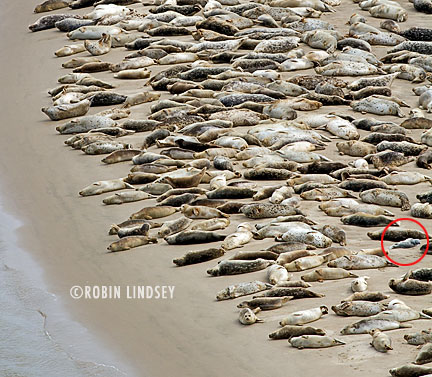
Haulouts, where seals gather in numbers throughout the year to rest and forage, become rookeries during seal pupping season (click here to view a map showing pupping season by region). Pregnant females seek safety in numbers to give birth and nurse their young. Yearlings, juveniles and adult males also gather at the rookeries during this time.
Before long, there will be lots of tiny pups calling out “maa-aa”, each with a unique voice so mom can find and nurse her hungry pup in the crowded, noisy colony. After the newborn pups have been weaned at 4-6 weeks old, adults mate. All of the seals (except the pups) then go through the molting process (shedding and growing a new fur coat), remaining onshore for more extended periods of time over the following weeks.
Sometimes, a pup will be seen away from a rookery - left alone onshore while mom forages. And not all pups are born in the relative safety of a busy haul out. If you come across a pup alone on the beach, stay back at all times (100 yards when possible) and observe quietly. Otherwise, due to human (or canine - always keep dogs leashed) interference, the mom may abandon her pup. If you have concerns that a seal pup may indeed be abandoned, please call the local stranding network for that area (click here for info). As the season progresses, weaned pups are quite often seen resting alone on shore. This is normal behavior as all seals need to rest and warm up for many hours a day. It is estimated that between 3,000 and 5,000 pups are born each year in Washington’s inland waters. However, only 50% will survive the first year.
Respect harbor seal haulouts - stay back! Disturbance has drastic consequences and can cause abandonment and starvation for newborn pups. Whether hiking or boating, always stay a respectable distance away - 100 yards if at all possible. It is truly a matter of life and death for vulnerable seal pups. Remember, harbor seals are protected by federal law, the Marine Mammal Protection Act.
WATCH WDFW’S SEAL CAM
For a real-time look at a harbor seal haulout in South Puget Sound, check out WDFW’s very cool and educational seal cam here. Pupping season will not begin at this or other area haulouts until late June, but there is always some fascinating seal activity to view live.







